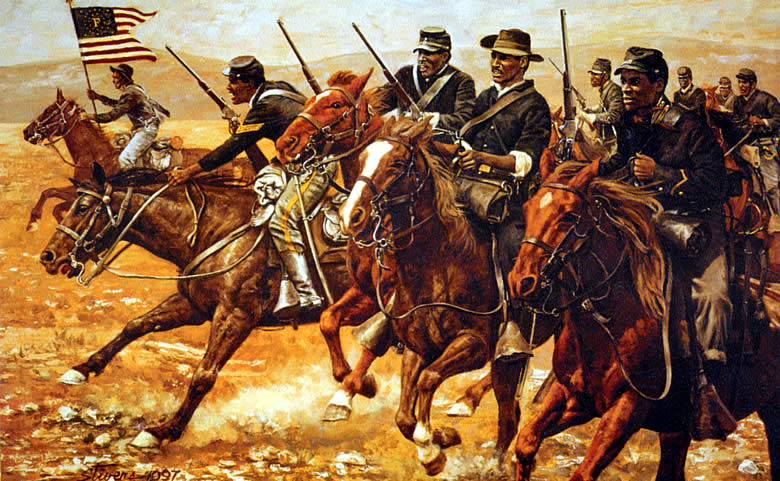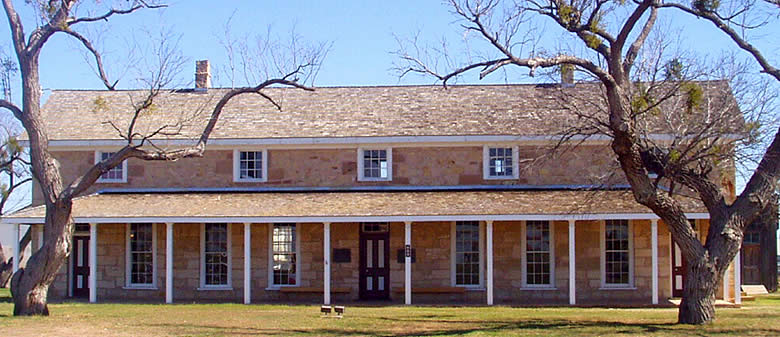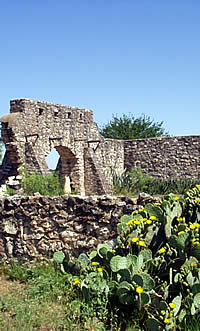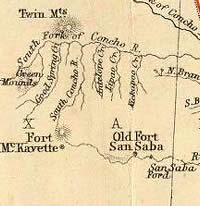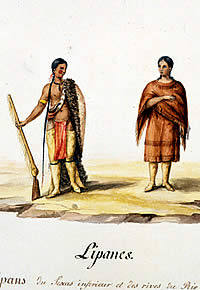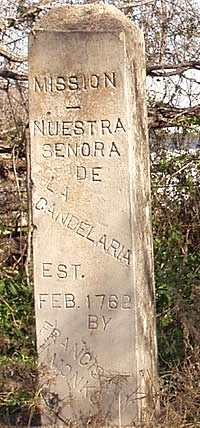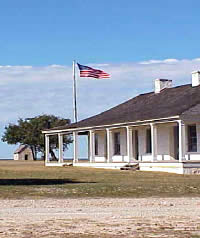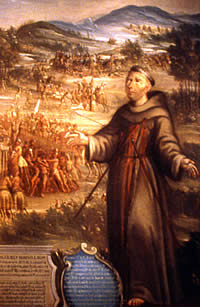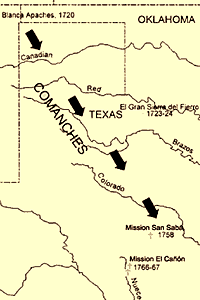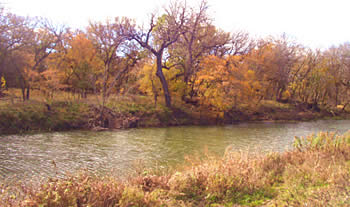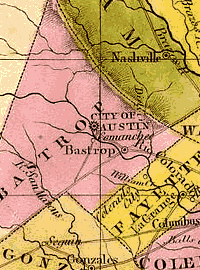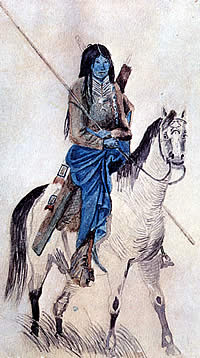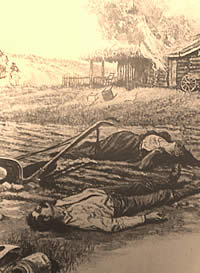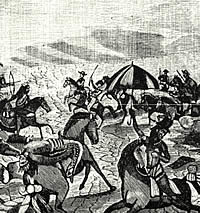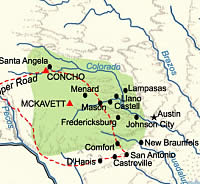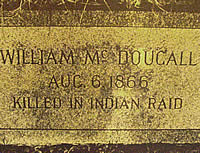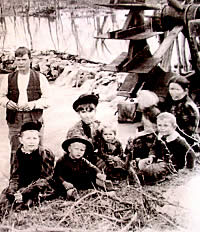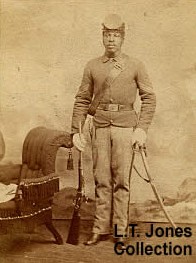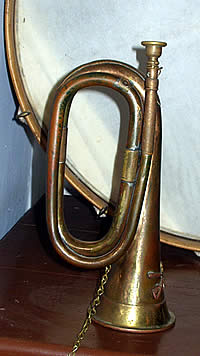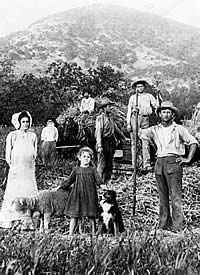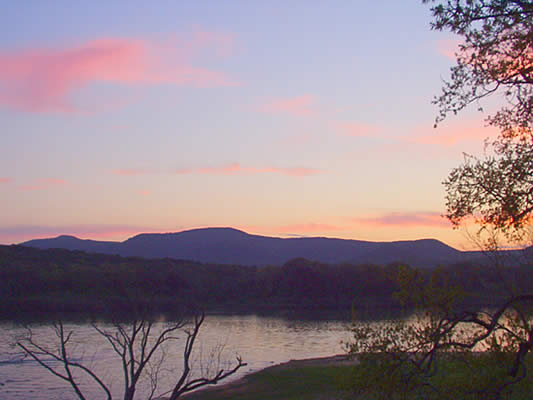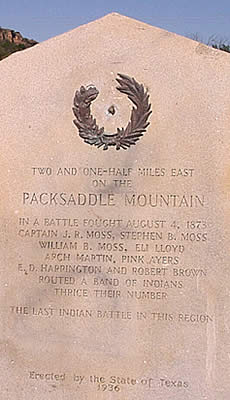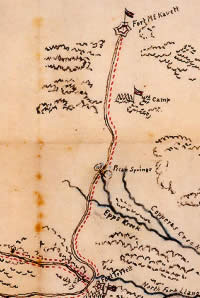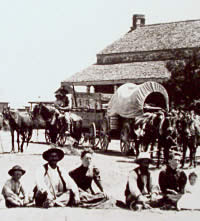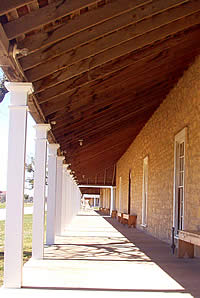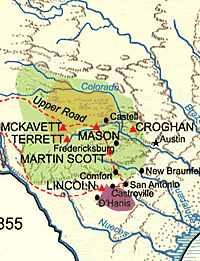
Anglo marks on the Hill Country frontier:
Army posts and some of the settlements in the 1840s
and 1850s.
|
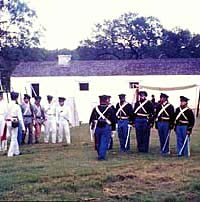
Fort Martin Scott, established in
1848 in Fredericksburg, was tasked with guarding the
German settlements on the western frontier. Here, history
interpreters depicting soldiers of the 1840s practice
drills in front of the guardhouse at the fort. Photo
by Roy Betzer, courtesy the Gillespie County Historical
Society.
|
|
It was quickly evident that most of the forts were
located too far east—on or behind the frontier
of settlement—to give even mounted troops a chance
to do anything about the raiders except chase them after
they had struck.
|
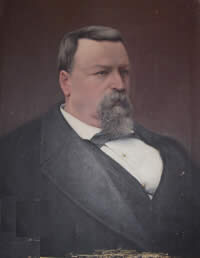
Llano County pioneer Gustave Schleicher
was a member of the Bettina Colony, established by the
Adelsverein in 1847 along with Castell and several other
small burgs on the Llano River. With the exception of
Castell, none of these early settlements —made
up chiefly of highly educated German freethinkers—survived.
Painting in Llano County Museum, Llano, Texas, gift
of Sam Schleicher.
|
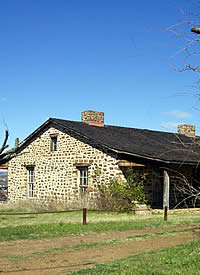
Situated high on a hilltop, this
reconstructed building at the site of Fort Mason commands
a view of the town below. Photo by Susan Dial.
|
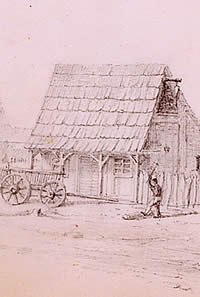
Dutch House in Frederickburg, Texas,
Residence of the Parson, January 28, 1849. Detail of
sketch by Seth Eastman. Courtesy of the McNay Art Museum,
gift of the Pearl Brewing Company.
|
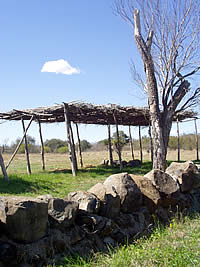
Reconstructed ramada shelter at site
of Fort Inge. The post was situated on the Leona river
west of Castroville, near the present-day town of Uvalde.
In the foreground is a wall made of igneous rock from
nearby Pilot's Knob. The low stone foundation of a fort
structure is visible in the background. Photo by Susan Dial.
|
|
By the mid-1840s, white settlement pierced the
Balcones Escarpment and began to creep up the Plateau's river
valleys. The first of these extensions was the colony of French
banker-diplomat Henri Castro, who settled his Alsatian immigrants
in the Medina River valley west of San Antonio. German immigrants
were drawn to the huge Fisher-Miller tract between the Llano
and Colorado Rivers, but settled first on the Guadalupe River
north of San Antonio and the Pedernales River to the northwest.
These communities—New Braunfels and Fredericksburg, respectively—combined
with Castroville to constitute what was considered at the
time to be the "Western Frontier" of white settlement
in Texas.
.
At the end of the United States' war with Mexico in 1848,
protection of Austin and the German and Alsatian settlements
became the responsibility of the U.S. Army. The southern anchors
of a "frontier line" of forts were placed near the
edge of the Edwards Plateau. Fort Martin Scott was established
in 1848 at Fredericksburg, the settlement most exposed to
Plains Indian raids. Then followed Fort Croghan, located near
the Colorado River above Austin; Fort Lincoln, on Seco Creek
north of the Alsatian hamlet of D'Hanis; and Fort Inge, on
the Leona River west of Castroville.
Although Fredericksburg may have appeared to
be the most vulnerable settlement, defense of the Castro Colony
occupied more of the Army's attention in the early 1850s.
The settlements at the base of the Balcones Escarpment frequently
were victimized by Indian raiders, and companies of the 2nd
Dragoons from Fort Inge and Fort Lincoln occasionally were
able to conduct a fruitful pursuit.
It was quickly evident, however, that most of
the forts were located too far east—on or behind the
frontier of settlement—to give even mounted troops a
chance to do anything about the raiders except chase them
after they had struck. The army's answer to this problem was
to abandon most of the original "frontier line"
of forts and to construct a second series of posts farther
west.
A garrison was retained at Fort Inge, the westernmost
of the original posts. Forts Croghan, Martin Scott, and Lincoln
were vacated. Fort Mason was established about 40 miles northwest
of Fredericksburg as a replacement for both Croghan and Martin
Scott. Fort McKavett was located near the headwaters of the
San Saba River, about 40 miles west of Fort Mason, and Fort
Terrett was placed about 40 miles south of McKavett on the
north fork of the Llano River.
Forts McKavett and Terrett were situated near
one of the Comanche travel routes from the Plains into Mexico.
This was a matter of some consequence. The United States,
as part of the Treaty of Guadalupe Hidalgo that concluded
the Mexican War, had agreed to try to stop Indian raids into
Mexico. Fort Inge, about 125 miles almost due south of McKavett
and just off the Edwards Plateau, gave the army a third post
near the Comanche trail.
This scheme, though logical, was at first ineffective.
Fort Terrett was abandoned in 1854, only two years after it
was established. Fort McKavett lasted seven years, but there
are no reports of Indian fights involving troops from the
post during that time. Companies of the 2nd Dragoons and the
Regiment of Mounted Riflemen garrisoned at Fort Inge directed
most of their attention to the Nueces Strip—the plain
between the Nueces River and the Rio Grande—because of
the frequency of raids on ranchos near Laredo.
The situation changed in 1856, with the arrival
and deployment of the 2nd Cavalry. This regiment was to become
one of the most celebrated units in the history of the United
States Army, and included 16 future Civil War generals among
its officer corps. Its commander, Colonel Albert Sidney Johnston,
established headquarters at Fort Mason.
Johnston and the regiment's lieutenant colonel,
Robert E. Lee, put the unit to the task of scouring the country
from the Brazos River to the Nueces—the entire Edwards
Plateau and then some—in search of Indians. The regiment
recorded more hostile actions against Indians than any other
U.S. Army unit in Texas prior to the Civil War. Nearly two-thirds
of the engagements occurred on the Edwards Plateau.
With the coming of secession and Civil War,
Texas frontier folk fell back on the same types of defenses
they had used during the Republic period: Texas-funded regular
troops (the "Frontier Regiment"), militia, and a
Frontier Organization that patrolled similarly to the rangers
of the Republic but functioned no more efficiently than militia.
By 1864, the frontier was under assault by northern Comanche
and their Kiowa allies.
Reports received from some officials of frontier
counties indicate 163 settlers killed, 24 wounded, and 43
carried away by Indian raiders during the period from the
summer of 1865 to the summer of 1867. Many of these were no
doubt from the counties north of the Edwards Plateau, above
the Brazos River, where settlements were particularly vulnerable.
But anecdotal reports from the Hill Country reflect a serious
enough condition there. From Llano to Lampasas, the stories
were the same: it had been 20 years since the Indians had
been so numerous, so well-armed, and so bold; farmers were
regularly being shot down in their fields, or their livestock
driven away as they watched helplessly; the frontier was "breaking
up," would have to be abandoned.
After the war, the state was prohibited from
fielding its own defense forces. The U.S. Army was quick to
get troops to the Rio Grande, but moved much more slowly to
the western frontier. This reflected the army's concern, and
that of the national government, for the international boundary
and the post-war Reconstruction mission. One company of the
4th Cavalry was posted to Fort Martin Scott early in 1866
and another to Fort Inge. In November and December of that
year, two companies were sent to Fort Mason and three to Camp
Verde, south of Fredericksburg in modern Kerr County.
|
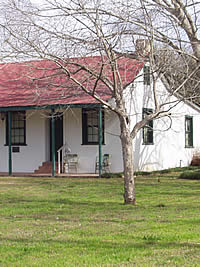
Home of Henri Castro, founder of
Castroville. Beginning in the early 1840s, Castro brought
settlers from Germany, Alsace-Lorraine, and France to
the far western edge of the frontier, some 30 miles
west of San Antonio. In spite of repeated Indian attacks,
disease, and severe drought in 1848, the community survived
and still thrives today. Photo by Susan Dial.
|
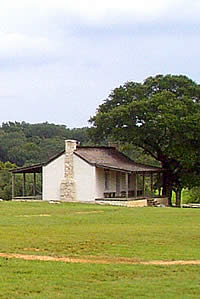
Buildings at Fort Martin Scott were
made of logs or of plastered limestone, the latter by
skilled German masons hired from among the Fredericksburg
populace. Photo by Susan Dial.
|
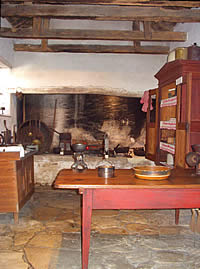
Early Fredericksburg kitchen. The
inviting warmth of the fireplace beckoned weary settlers
at day's end on the Texas frontier. Shown is the 1840s
Kammlah house in Fredericksburg, now maintained as part
of a museum complex by the Gillespie County Historical
Association. Photo by Susan Dial.
|
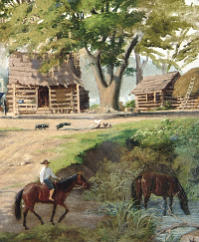
Block House, or Log Cabin, New Braunfels. Detail from painting
by early Texas artist Carl G. von Iwonski, courtesy of the Daughters of the Republic of Texas Library, Yanaguana Society Collection. Click to see full painting.
|
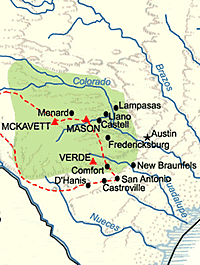
Hill Country frontier after 1855. |
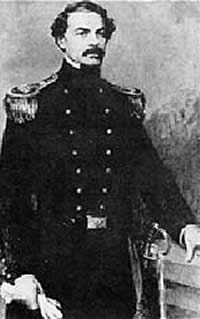
Robert E. Lee was one of numerous
officers posted to the Texas frontier who became Civil
War generals including Albert Sidney Johnston, Earl
Van Dorn, E. Kirby Smith, George H. Thomas, John Bell
Hood, and William J. Hardee. Johnston established the
2nd Cavalry's headquarters at Fort Mason, with Lee second
in command.
|
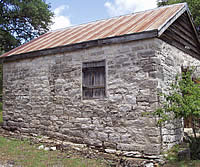
Powder magazine at site of Fort Croghan in Burnet. The
building, used by local settlers before and after the
Civil War, is the only remaining military structure at
the site of the early fort. Photo by Susan Dial. |
|
